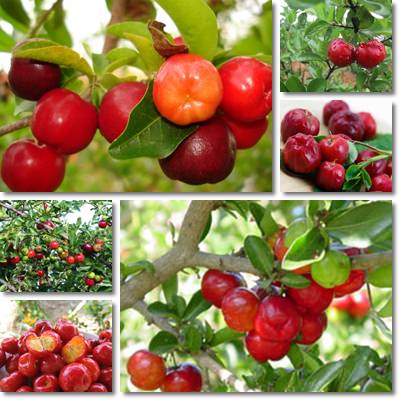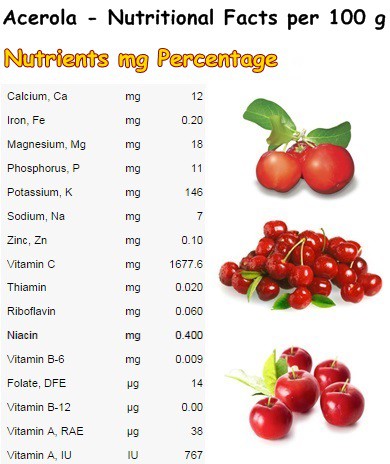Also known as the Barbados cherry or the West Indian cherry, acerola (Malpighia emarginata) is one of the richest food sources of vitamin C, probably the most potent antioxidant known to man.
Acerola is native to Central and South America, but is now successfully being introduced in other subtropical regions of the Asian continent.
The fruit is commonly known as acerola or acerola cherry, but goes by other names as well: West Indian cherry, Barbados cherry, Puerto Rican cherry, Antilles cherry or wild crepe myrtle.
What does acerola look like?
The acerola tree is so small that it looks more like a shrub. It has fine branches, evergreen leaves and quite shallow roots which is why it has an extremely poor tolerance to low temperatures.
As seen in the image below, acerola looks a lot like your ordinary cherry, hence its other names (acerola cherry, Barbados cherry etc.).
Ripe acerola cherries are round, bright red fruit with 3 lobes on the bottom, a feature reminiscent of bell peppers which also have lobed bottoms.

Each fruit is about 1-3 cm in diameter and weighs in between 3 and 5 grams which means acerola is smaller than sweet cherries.
Fruit grow in clusters of two or three and each has three small, triangular seeds.
It usually takes three to four weeks for the unripe, green acerola to reach maturity and be ready for picking.
While they may hold great nutritional value, acerola fruit need to be consumed soon after harvesting because they spoil very easily. Also, attention should be paid when picking the fruit because of their thin skin which bruises fairly easily.
What does acerola cherry taste like?
Acerolas have a distinct sour taste as a result of the fruit’s high vitamin C content. However, the riper the fruit, the less acidic it becomes. Perfectly ripe acerola cherries tend to have a sweeter taste. This is because the riper the fruit gets, the more vitamin C it loses.
What does acerola cherry juice taste like?
Acerola cherry juice may have a more or less sour taste depending on the age of the fruit at harvest time, processing undergone (e.g. sweetening) and origin of the fruit.
According to a study in the Food Science and Technology International journal, unripe, underripe and barely ripe acerola has up to two times more vitamin C than the ripe ones fruit. Growing conditions have a significant impact on the fruit, producing differences in taste and nutrition and benefits for health.
Growing conditions can deeply influence nutrient and antioxidant content in food via variations in soil quality and nutrient availability, climate and weather conditions that determine amount of rainfall and sunlight received by the plant. So don’t be too surprised if you may come across acerola cherries that taste different, whether it’s sweeter or more sour than you’re used to, or notice significant differences in nutritional status.

What are the health benefits of acerola cherry?
According to researchers, acerola cherries are an incredible source of potent antioxidants in the form of polyphenols and vitamin C. Studies recognize acerola as being the second best source of vitamin C in the fruit world. In addition to this, it also contains important amounts of other essential nutrients such as vitamin A, B vitamins, calcium, iron, potassium and magnesium. All of these combined result in the following 5 major health benefits of acerola cherries.
High antioxidant value
As mentioned above, acerola is an incredible source of antioxidants, in the form of polyphenols, carotenoids and antioxidant-vitamins such as vitamin C. Basically, antioxidants scavenge free radicals (reactive oxygen molecules) from the body, protecting cells and DNA from damage buildup that may disrupt their normal activity. At higher levels, this translates into firm skin, better vision, low inflammation levels, lack of and lower risks of developing diseases such as diabetes, cancer, cardiovascular disease, dementia and so on.
Potent anticancer properties
Because of its extremely high vitamin C content, the acerola is considered to offer excellent protection against cancer. Basically, vitamin C protects cells and DNA from free radical damage that may disrupt cellular activity and reduces inflammation markers greatly.
Free radical damage may alter cells’ normal life cycle and, instead of dying when they are programmed to, they keep replicating, resulting in tumors and cancer. Vitamin C helps regulate cellular activity and prevents such abnormal behaviors. It also helps reduce inflammation in the body, a factor recently shown to create a predisposition for chronic disease.

Prevents scurvy
A severe vitamin C deficiency causes a disease called scurvy. Vitamin C deficiency affects teeth and gums, increasing risks of tooth loss and gum disease.
Vitamin C deficiency causes poor healing wounds and weak tissues, including weakness in blood vessel walls and loss of skin elasticity, poor immunity and reduced fertility in addition to many more side effects.
Although not so common nowadays, except for people suffering from extreme malnutrition, vitamin C deficiency is a potentially life-threatening condition that can cause death by bleeding if severe, teeth loss and increased susceptibility to infection and disease. Acerola cherries are one of the best sources of the essential nutrient, perfect for correcting a deficiency and building a strong system.
Acerola cherry vitamin C content
How much vitamin C in acerola cherries? Acerola cherries were found to contain 1667.6 mg (milligrams) of vitamin C per 100 grams of raw, fresh fruit, an incredibly high amount of the nutrient. The content of vitamin C in acerola cherries is one of the highest in the plant world.
Compare the vitamin C content of acerola cherries to that of other foods:
- Bell peppers: 127.7 mg (milligrams) of vitamin C for every 100 grams
- Kiwifruit: 92.7 mg
- Broccoli: 89 mg
- Brussels sprouts: 85 mg
- Papaya: 61.8 mg
- Strawberries: 58.8 mg
- Oranges: 53.2 mg
- Pineapple: 47.8 mg
- Cantaloupe: 36.7 mg
Compared to other common food sources of vitamin C, acerola cherries are an invaluable source of the essential nutrient. The acerola cherry is actually the third best source of vitamin C after camu camu with 1800-2200 mg of vitamin C per 100 grams (see benefits of camu camu) and the Kakadu plum or billy goat plum with 2300-3100 mg of vitamin C per 100 grams (see benefits of billy goat plum).
Protects the retina and ensures good vision
Acerola contains powerful carotenoid pigments that help protect eyesight by preventing free radicals from light from damaging the retina. In addition to this, the vitamin A from the fruit ensures good night vision and contributes to better visual acuity.
Overall good source of vitamins and minerals
As mentioned above, acerola is a good source of important nutrients such as vitamin A, thiamine, riboflavin, niacin, vitamin B9, calcium, iron, magnesium, phosphorus and potassium, not to mention its amazing vitamin C content.
Either eating the fruit fresh or turning it into a refreshing juice will add important amounts of essential nutrients to your diet, boost energy levels and contribute to keeping in good health.
Conclusion
Unfortunately, acerola cherries are only available fresh at local markets or supermarkets nearby plantations or from a tree in your possession. This is because the fruit tend to spoil very quickly and bruise just as easily.
For instance, acerola cherries may be kept, in ideal conditions, for up to five days, after which they start fermenting. Also, studies suggest that you get the maximum of health benefits if you eat the fruit in no more than a few hours after having been harvested.
Acerola supplements are available in some countries and they (should) contain acerola powder or extract that can be added to homemade fruit or vegetable juices.
They are said to improve collagen production and resistance to physical effort, treat gum problems and sores, prevent cavities, scurvy, help with allergy symptoms as well as reduce the severity of asthma attacks.
All of these health benefits are a direct result of the fruit’s out of the ordinary vitamin C content.
